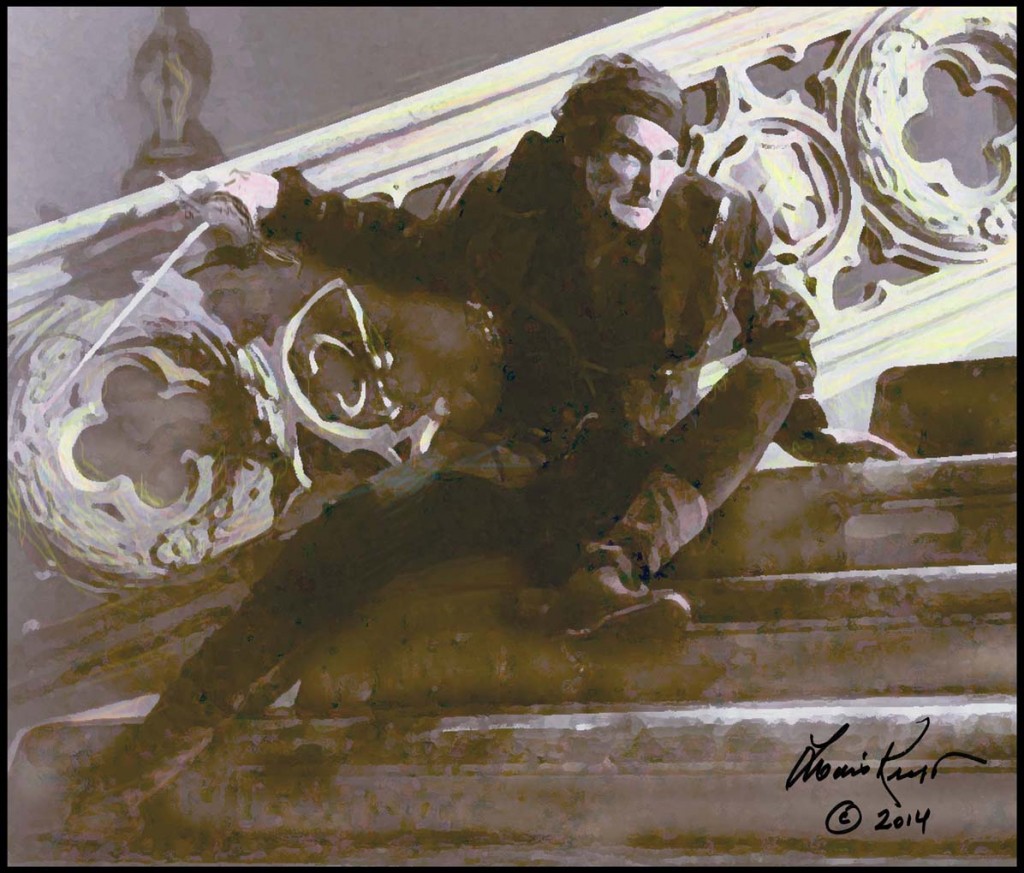Website & blogs © Louis Kraft 2013-2020
Contact Kraft at writerkraft@gmail.com or comment at the end of the blog
I thought that I had completed my work on my “Geronimo’s Gunfighter Attitude” article for the October 2015 issue of Wild West magazine until I would proof the design layout. No! The article now requires more work. As must be expected the World History Group, which now owns the former Weider History Group’s stable of history magazines, is making major changes to the look and feel of the magazines. … This affects the entire publishing staff in Leesburg, Virginia, as well as the freelance writers that contribute to the magazines. This blog not only preempts my work on Sand Creek and the Tragic End of a Lifeway, it has also preempted my ongoing work on upcoming blogs.
Just for fun, a quick change of pace …
Sudeshna Ghosh, my friend and former manager at SeeBeyond Technology Corporation and Sun Microsystems liked this image of LK (at left). Russ Williams, a writer, screenwriter, novelist, and friend dating back to the early SeeBeyond days and beyond also liked this image, which was taken earlier this year. I actually don’t like what I look like, and this simply means that my appearance constantly changes. That said I do like this image, which has appeared on other social media. Both Sudeshna and Russ liked the long hair (and long hair is decades in my past). Still pirates and frontiersmen wore their hair long, as did the Cheyennes and Apaches. Perhaps it is time for LK to belly up to the people he writes about. Ned Wynkoop, Kit Carson, George Armstrong Custer, Black Kettle, Geronimo, Bull Bear, Roman Nose, if I want to walk with you perhaps it is time that my hair is as long as you wore your hair. (photo © Pailin Subanna-Kraft & Louis Kraft 2015)
I’m okay with birthdays except for mine, which I absolutely hate. Since mine is long past I feel safe mentioning it here. Most of you probably think that I’m a motor mouth. Not true. Actually there are many things that I keep very secretive. One happens to be my birthday. This is my least favorite day of the year. Mainly because it loudly proclaims: “Kraft, the clock is ticking and now you have XXX days left.” Not my favorite thought. … All this negativity finished, and since my BD is now far in my rearview mirror, I feel safe to post an image that was taken on that dreaded day at Tujunga House. I’m wearing the cool shades that Pailin had given me (the first non-prescription sunglasses that I’ve owned in 35 years). The new LK? Maybe. For how long? That is a great question for I don’t have a clue. Maybe tomorrow, maybe next week, or maybe next month. Flip a coin for any date beyond the end of May.
Life moves forward & as Ernest Hemingway proclaimed the sun also rises …
All of my proposed blogs haven’t gone live. Why? There’s a reason, but I hate excuses for they are BS. Sorry, but ’tis the truth. Read to the end of this blog and you’ll have at least a hint of the upcoming blogs’ status.
Music plays a large part in my writing world (although I never used it while writing software documentation). … Alan Jackson, Michael Parks, Waylon Jennings, John Lennon, Rhiannon Giddens, Rihanna, Patsy Cline, Elvis Presley, Tex Ritter, John Anderson, world music (especially Andean, Chinese, and Native American), but perhaps my all-time favorites are film soundtracks (classic music too, but to a much lesser extent).
An LK rendering of the final duel in Flynn’s Adventures of Don Juan (right). Something needs to be explained here, and it is very important. To succeed film duels must have three pieces in place: Choreography, performance by the actors and stunt men, and a great editor. If not, the film audience yawns and mumbles “ho-hum” before they fall asleep. I hate to say it but this most often happens, and especially in modern times. Trust me on this view. I learned how to fence while as a teenager I studied under Olympic competitor and film stuntman and choreographer Ralph Faulkner, fought saber competition in college, and as a professional actor learned stage combat and choreographed and fought duels. (art © Louis Kraft 2015)
This week Hugo Friedhofer’s musical adaptation for the film version of Ernest Hemingway’s The Sun Also Rises (20th Century Fox, 1957, which has a great cast including Tyrone Power, Ava Gardner, Mel Ferrer, who I luckily interviewed before his death, Errol Flynn, Eddie Albert, and Juliet Greco) shares time with Blue, the obscure Manos Hadjidoakis score for the Terence Stamp Paramount Pictures western film (1968); Ernest Gold’s magnificent score for the 1960 Paul Newman film Exodus; Klaus Doldinger’s score for Das Boot (Columbia Pictures, 1981, which I saw on the day that it opened in San Francisco while playing Miles Hendon during a 135-performance tour of The Prince and the Pauper. … I accepted the role as it included me choreographing and fighting the duel, and better yet getting to say much of the dialogue that had been stolen from Flynn’s 1937 Warner’s film of the same name); and Max Steiner’s magnificently composed and conducted score of Errol Flynn’s Adventures of Don Juan (Warner Bros., 1948).
Progress on the Sand Creek manuscript
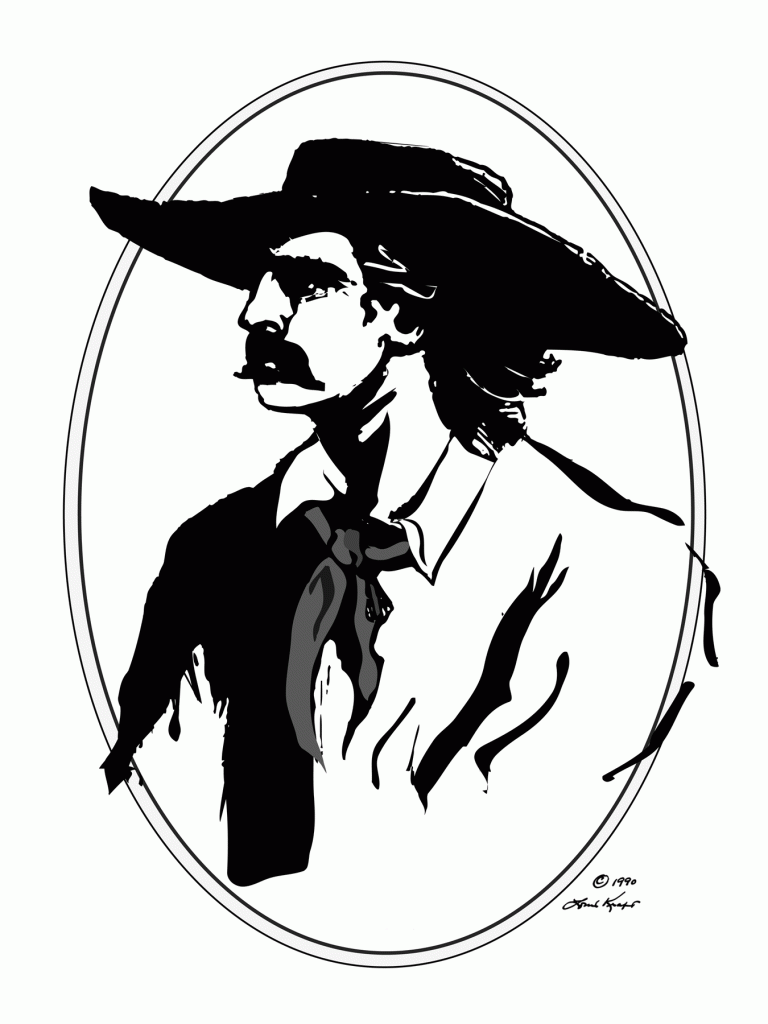
In 1990 I moved to Thousand Oaks, California, and was soon after under contract to write The Final Showdown (Walker and Company, 1992). I had always excelled at art in school (no collage classes) and had even contracted artwork and attempted (“attempted” is the key word here) during the 1970s and 1980s to experiment. Nineteen-ninety was a key year for me as I decided to play around with pen and ink. This image of Ned Wynkoop (based upon an 1867 woodcut) was the result. It saw publication in Custer and the Cheyenne (Upton and Sons, 1995). (art © Louis Kraft 1990)
Ouch!!! I thought that perhaps I’d talk about progress writing about Colorado territorial governor John Evans, Rocky Mountain News publisher and editor William Byers and his wife Elizabeth, Episcopal Father John Kehler (the correct spelling of his last name) and Ned Wynkoop.
Nope. Not today.
Oh heck, … I don’t want to be a killjoy. At this point in time, Evans is standalone in the manuscript, but I know that he’ll have connections with Wynkoop and I’m certain with Byers. In one way or another, Byers, Elizabeth, Kehler, and Wynkoop are already connected or will be connected with each other. The question here is, what scenes of them together; especially between Byers and Wynkoop will make it into the draft and not be edited out of it by the time of the final delivery? Arrival timing in Denver for Byers, Elizabeth (different dates), and Kehler have proved problematical but I’m now good to go with them. Progress is good … and maybe even great (from my point of view).
For what it is worth, Byers, Wynkoop, Black Kettle, Little Raven, Colonel John Chivington, Evans, mixed-blood George Bent, and his father trader William Bent will most likely be the leading players in the manuscript. Hopefully others will also play leading or major supporting roles (my research is key here). At the moment Elizabeth Byers is by far my leading lady (unfortunately I just don’t have enough about her, the Cheyenne woman Mo-nahs-e-tah, or even Wynkoop’s wife Louise).
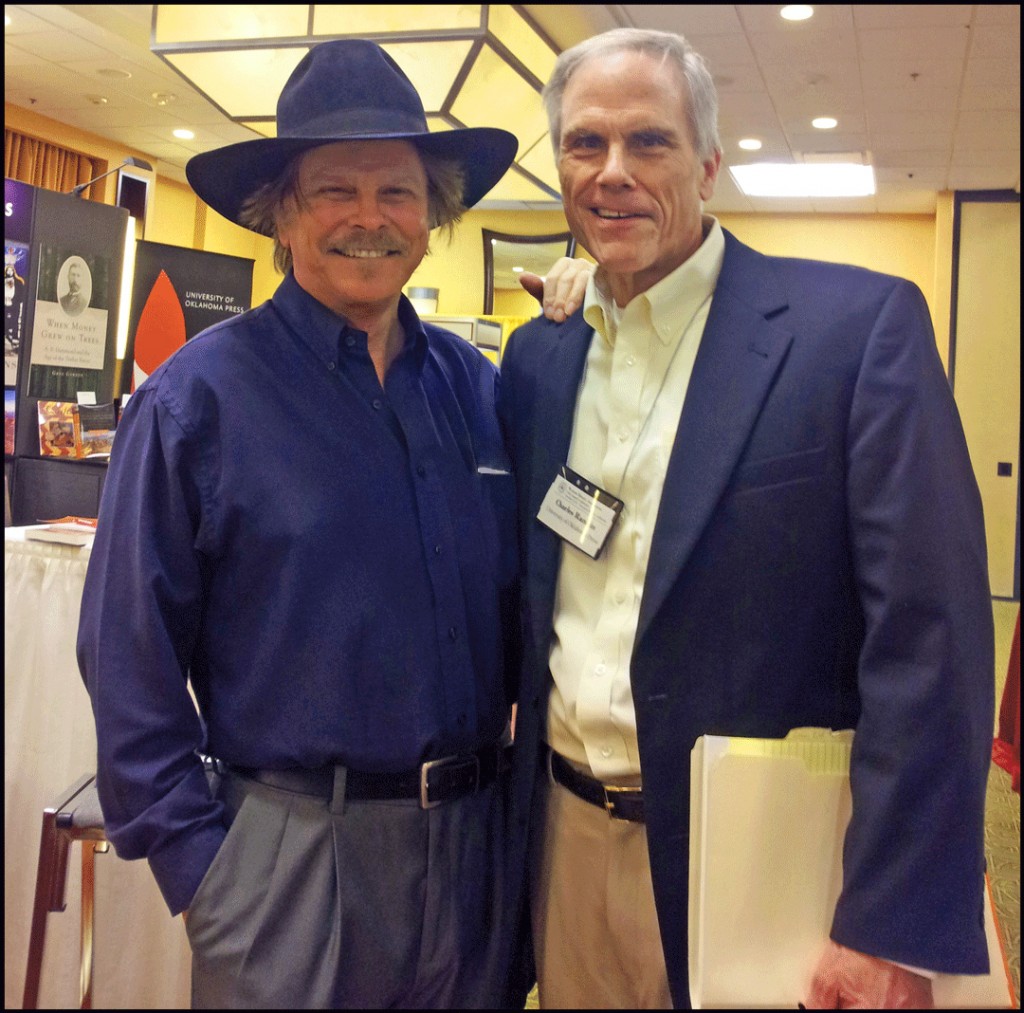
LK & OU Press Editor-in-Chief Chuck Rankin at the Western History Association (WWA) convention in Newport Beach, Ca., on 17oct2014. (photo by Pailin Subanna-Kraft; © Louis Kraft, Pailin Subanna-Kraft & Chuck Rankin 2014)
OU Press editor-in-chief Chuck Rankin and I both want to highlight the women as much as possible. To do this, I need to find the information (if it exists). A fellow writer-historian Linda Wommack has offered to help with Elizabeth. I told her that I wanted to get what I knew about Elizabeth in place first, so that I don’t waste any of her time. Am looking forward to our upcoming (alas, long distance) time together. I have located a great image of Elizabeth that I want to use in Sand Creek and the Tragic End of a Lifeway, but have seen it dated to both the mid-1860s and mid-1870s. Fingers are crossed that it dates to the 1860s, for if it is from the the 1870s it is out of the scope of the book and I won’t use it. Although I had purchased a low-resolution copy of the image I do not have the permission to post it. Too bad, for it is a great image.
What you see here is an invitation to speak up if you can share information about other key players in the Sand Creek story, including, but not limited to, trader and Cheyenne interpreter John Smith; Major Scott Anthony; Captain Silas Soule; Chivington’s subordinate officers in the Third Colorado (especially George Shoup); as well as other Cheyennes and Arapahos, such has Tall Bull, Bull Bear, Stone Forehead, Lean Bear, Little Raven, and Left Hand (BTW, a bio on Left Hand at times uses notes that are either inaccurate or don’t support the text, which makes the research questionable); Wynkoop’s subordinate Lieutenant Joseph Cramer; and Cheyenne mixed bloods Edmund Guerrier, Charley Bent, and Jack Smith. Over the years I’ve mined Anthony and Soule heavily at History Colorado and at the Western History Department at the Denver Public Library, but I’m certain that there is more on them that I haven’t seen.
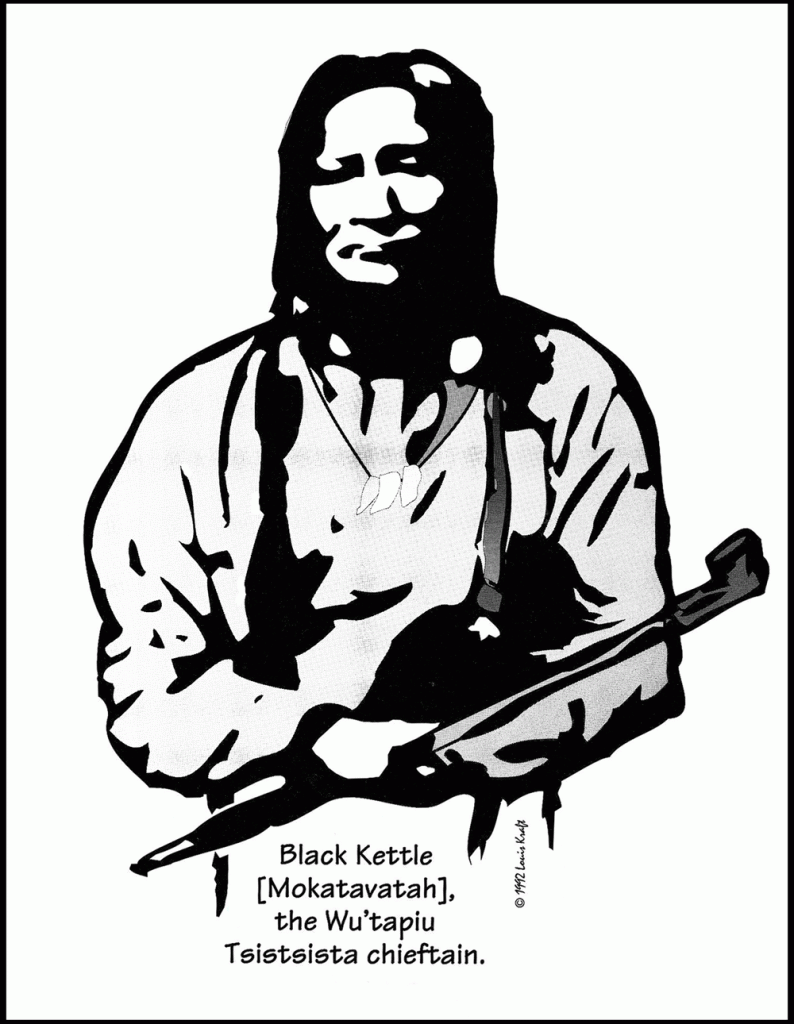
This image of Black Kettle was also an early LK attempt at illustrative art. It also was published in Custer and the Cheyenne. I placed it here just to grab your attention, as I want to bring the chief into the Sand Creek book as soon as possible and I don’t have much on his early life.
The goal is to bring the people in the manuscript to life. It is easier to do with participants that were verbal and left a lot of documentation in letters and other writing or had their actions constantly reported in the press. Guerrier was literate but didn’t leave much behind while George Bent left a goldmine of letters (all of which I have in house, either in his hand or in typescript form).
I know that I have said the following before, but it is worth repeating. I don’t write about good guys and bad guys. My opinion will not be in the book, but if I do my job properly the actions of the people I write about will allow you to form your own view of them. The following is also worth repeating: It is what a person does and not what he or she says about themselves that defines who they are or were.
Kit Carson is in LK’s future
I don’t think that Kit Carson is a supporting player in the Sand Creek story (he is minor at best), but he will be a major player in my writing future (anything you can share about Kit is of great interest to me, and at all times). As far as Kit goes, be warned for I believe that I have all of the books published about him in the 20th and 21st centuries. I also have the bio (in hardbound) based upon what he told DeWitt C. Peters in 1859, as well as a few other 19th century volumes that were accounts of a piece of time spent with Kit and not bios or dime novels. I’m especially interested in his relationship with Indians (yes, the plan is to follow how I wrote about Custer, Gatewood, and Wynkoop).
The World History Group flexes its muscles and takes a bite out of my ass
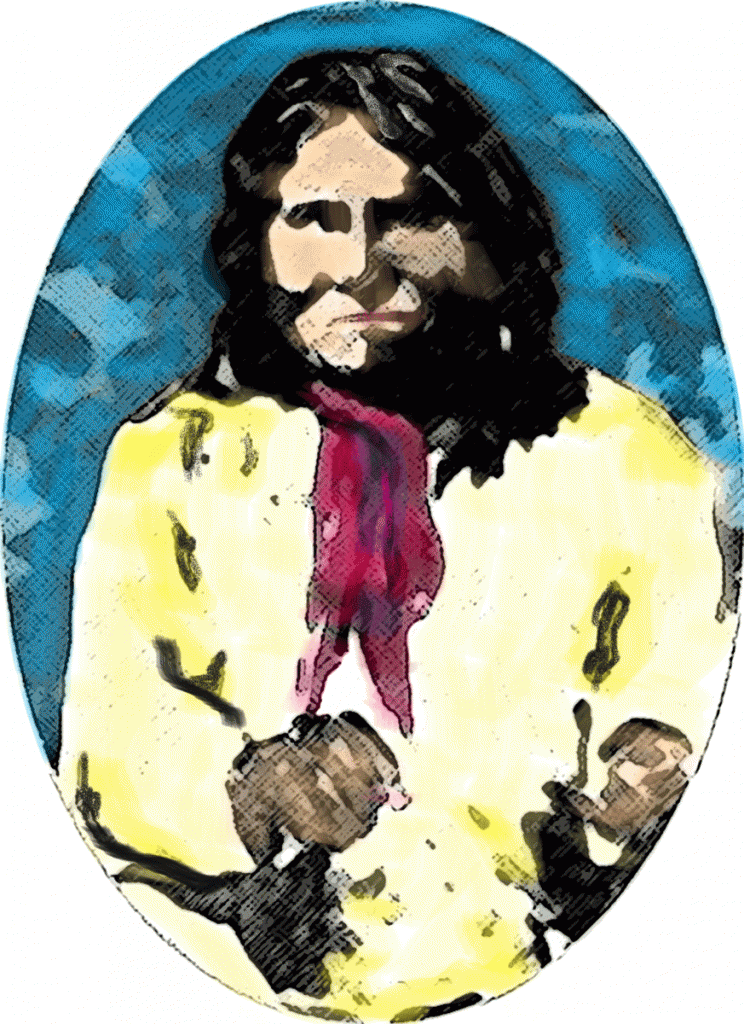
LK art of Geronimo based upon the cover art that I created for Gatewood & Geronimo (University of New Mexico Press, 2000). This is just LK playing around with color and line. It isn’t very good and it will never be published. I view art as a learning process, and that is experimenting and trying to create an image that is decent. This is an ongoing process.
No, no, … no … NO!!! I received the World History Group contract for “Geronimo’s Gunfighter Attitude” (October 2015 issue of Wild West, and soon to go into production) on 27apr2015.
Editor Greg Lalire and I had already gone through our copyediting (which usually gets tweaked while in production) and we were good to go with the 3800-word feature. Just like in the IT software world, the times they change and to survive a writer must dodge and duck and go with the punches while standing upright. It’s called survival. Greg and I began our working relationship 20+ years ago. Over this time we have become good friends, and we help each other out when needed. Greg is doing what he can to survive the change happening with the 11 or 12 great history magazines that the World History Group now owns (I’ve been there and have done that way-too-many times in the software industry). Greg is a great editor, and he’s also a damned good writer. He will survive.
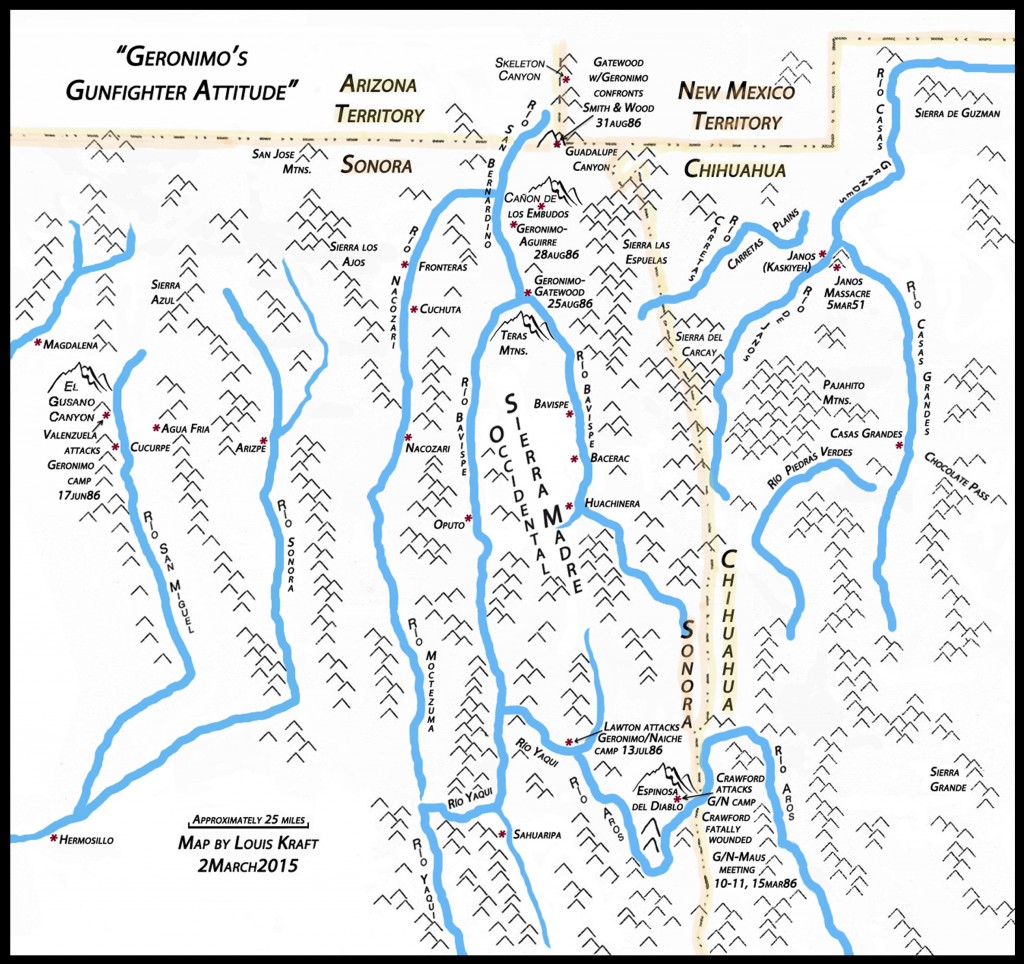
I created this map for the “Geronimo’s Gunfighter Attitude” October 2015 Wild West article. If it is used, the contractor for Wild West, Joan Pennington, will create the final artwork (and she does good work). Back in 1999 I submitted one of the final pieces of art that was published in Gatewood & Geronimo to Wild West, it was recreated and published in the magazine with no credit (or payment to LK). I complained this time around, and if the map is published I will receive a “based upon” credit. Good, for this is the first time I have ever seen the Valenzuela ambush location and the Gatewood/Geronimo confrontation with Smith & Wood added to a map, and both are major pieces to the Geronimo story. (map © Louis Kraft 2015)
I study my contracts, and anything that is questionable, is not in line with what I want, or what has suddenly become a concern I confront immediately. The contract stated 3800 words. The “3800” was marked out in ink and replaced with “3200.” What? Did I lose 600 words and didn’t see the edit? I called Greg. My timing was perfect. He was typing an email to me that explained what had happened—and it got worse. The “3200” words is now “3000” words, and this word count would now be the maximum for a feature.
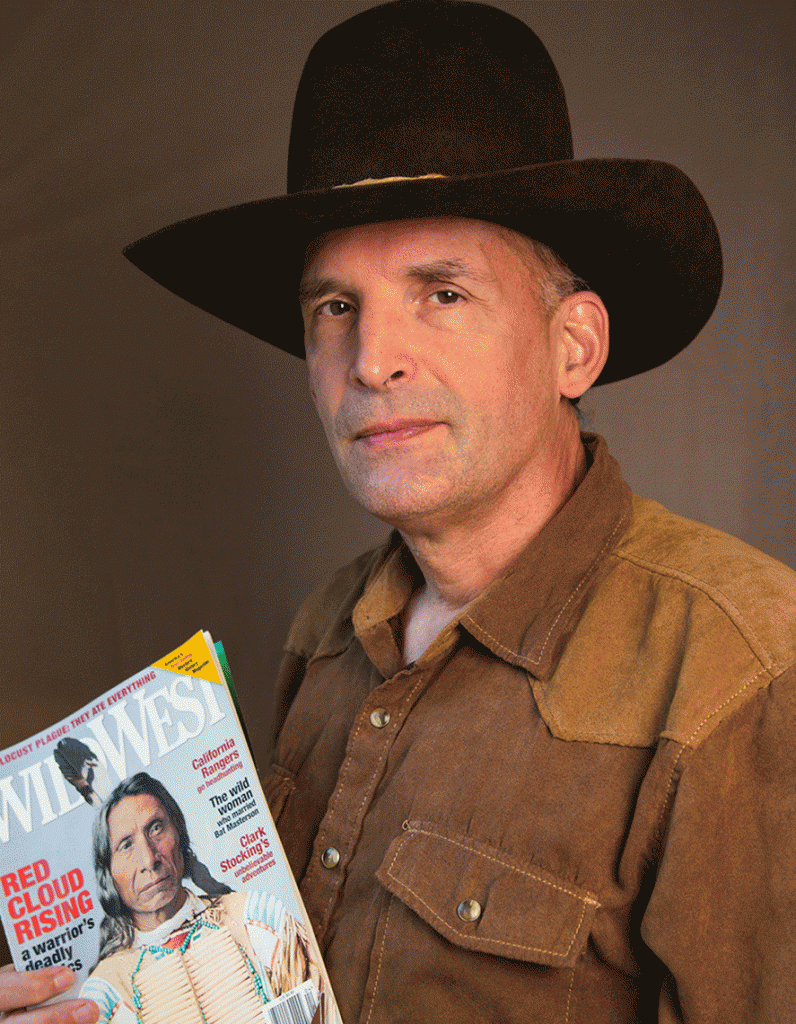
Gregory J. Lalire’s dust jacket image for his novel: Captured: From the Frontier Diary of Infant Danny Duly (Five Star, 2014)
World History Group wants to mimic the Cowboys & Indians magazine, that is they want to obtain better advertisers. I consider the feature content in Cowboys & Indians as little more than fluff (which I can’t stand; oops, I shouldn’t have said that—disregard what you just read). Cowboys & Indians is big on color and images, and even bigger on good advertising. … That, ladies & gents is the future of Wild West, American History and MHQ (three key magazines in my life) while keeping the same historical content these magazines have always had in the past.
My opinion doesn’t count here, for the publisher has every right to do what they think they need to do to stay in business. I agree with this, and as it was with the IT software companies, they need to survive to employ me.
While work is in progress Greg and I always keep good phone or email contact with each other. “Believe me,” he wrote me yesterday, “I know all about the pain of cutting, but as I found out in August, a story can still be strong at a shorter length.” (He is talking about the August 2015 issue of Wild West.)
I have 800 words to cut from a 3800-word article (that is a little over 20 percent of the word count). I will do what is required, and we’ll find out if the article still retains its impact. Hope so.
A few words on long overdue blogs …
For those of you who are wondering about upcoming blogs here’s an update. A blog dealing with what could be a major change in my writing world is ready to post (I just need reality and the future to merge in the present). …. Don’t ask, for I ain’t talkin’. The Thai walkabout blog continues to be written (and it will be an eye-opener, for you and for me, if I ever post it), and I have finally begun to draft the unscrupulous writer-historians blog (and it will not be vague, but to be honest this being posted is iffy at best—and you know the reason why). Trust me, for if I ever post the unscrupulous blog—and again, “if ever” are the key words—I will forever sit with my back to a wall with two Colts crossed over my chest like Wild Bill Hickok. People will be gunning for me and if—God forbid—my life ends in violence it will be because someone is angry over what I have posted. This is not how I view my end so I hope and pray that my dark vision of my future never comes to pass.
A few people that know me believe one, and only one thing, about me—that I’m good at dramatics. I don’t agree, but my fear of the future is out there, for knowing my past I am aware that unsavory events can and do happen.


